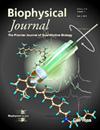The role of ester- vs. ether-linked phospholipids in the ability of biological membranes to accept protons and support proton diffusion.
IF 3.2
3区 生物学
Q2 BIOPHYSICS
引用次数: 0
Abstract
In biology, the distribution of ester-linked vs. ether-linked phospholipids is meaningful, such as in the abundance of ether-linked phospholipids in archaea vs. ester-linked phospholipids in bacteria/eukarya, and the presence of ether-linked phospholipids in some tissues of higher eukaryotes. Owing to biological membranes' capability of proton acceptance and supporting proton diffusion (PD) on their surface, e.g., in bioenergetics, it was envisioned that the phospholipid linkage might condition the proton transfer (PT) and PD properties. Here, we explore how and if such differences in membrane composition result in attenuation in the PT/PD properties of biological membranes by using a light-gated membrane-tethered proton donor. We reveal that the PT/PD properties differ between the membranes and between the two phases of the membranes (liquid vs. gel phase). At the liquid phase, we found that the headgroup dominates the PT/PD properties, whereas the ester-/ether-linkage has no substantial role. However, at the gel solid phase, such linkage has a significant role in determining both the PT from the probe to the membrane and the subsequent PD properties. Surprisingly, we found that the PT from the probe to the surface of the ether-linked lipid membrane was faster than that of the ester-linked lipid membrane. We explain this finding by the extracted dimensionality of PD. We show that in the gel phase, the ester-linked lipids create a proton pathway with PD dimensionality close to unity, resulting in poor PT, whereas the ether-linked lipids allow lateral PD and a faster PT. The PT/PD properties of the ether-linked lipid membranes also appear mostly insensitive to exterior bulk protons, which might be ascribed to the inner polar part of such membranes. Since bioenergetics is fundamental within cells, the different capabilities of the membranes to support PT/PD might explain the evolutionary constraints of their formation and their presence in certain mammalian tissues.酯与醚连接磷脂在生物膜接受质子和支持质子扩散能力中的作用。
在生物学中,酯链磷脂与醚链磷脂的分布是有意义的,例如古细菌中醚链磷脂的丰度与细菌/真核生物中酯链磷脂的丰度,以及高等真核生物中某些组织中醚链磷脂的存在。由于生物膜具有质子接受和支持其表面质子扩散(PD)的能力,例如在生物能量学中,人们设想磷脂键可能会影响质子转移(PT)和PD的性质。在这里,我们通过使用光门控膜系缚质子供体来探索膜组成的差异如何以及是否会导致生物膜的PT/PD特性衰减。我们发现膜之间以及膜的两相(液体相与凝胶相)之间的PT/PD性质不同。在液相中,我们发现头基主导PT/PD性质,而酯/醚键没有实质性的作用。然而,在凝胶固相,这种连接在决定从探针到膜的PT和随后的PD性质方面起着重要作用。令人惊讶的是,我们发现从探针到醚连接的脂质膜表面的PT比酯连接的脂质膜要快。我们通过提取PD的维数来解释这一发现。我们发现,在凝胶相中,酯连接的脂质产生了一个质子通路,其PD维数接近于统一,导致PT差,而醚连接的脂质允许侧向PD和更快的PT。醚连接的脂质膜的PT/PD特性对外部体积质子也不敏感,这可能归因于这种膜的内极性部分。由于生物能量学是细胞内部的基础,膜支持PT/PD的不同能力可能解释了它们在某些哺乳动物组织中形成和存在的进化限制。
本文章由计算机程序翻译,如有差异,请以英文原文为准。
求助全文
约1分钟内获得全文
求助全文
来源期刊

Biophysical journal
生物-生物物理
CiteScore
6.10
自引率
5.90%
发文量
3090
审稿时长
2 months
期刊介绍:
BJ publishes original articles, letters, and perspectives on important problems in modern biophysics. The papers should be written so as to be of interest to a broad community of biophysicists. BJ welcomes experimental studies that employ quantitative physical approaches for the study of biological systems, including or spanning scales from molecule to whole organism. Experimental studies of a purely descriptive or phenomenological nature, with no theoretical or mechanistic underpinning, are not appropriate for publication in BJ. Theoretical studies should offer new insights into the understanding ofexperimental results or suggest new experimentally testable hypotheses. Articles reporting significant methodological or technological advances, which have potential to open new areas of biophysical investigation, are also suitable for publication in BJ. Papers describing improvements in accuracy or speed of existing methods or extra detail within methods described previously are not suitable for BJ.
 求助内容:
求助内容: 应助结果提醒方式:
应助结果提醒方式:


